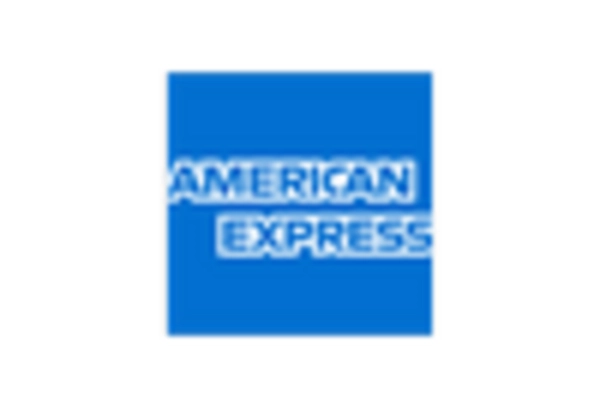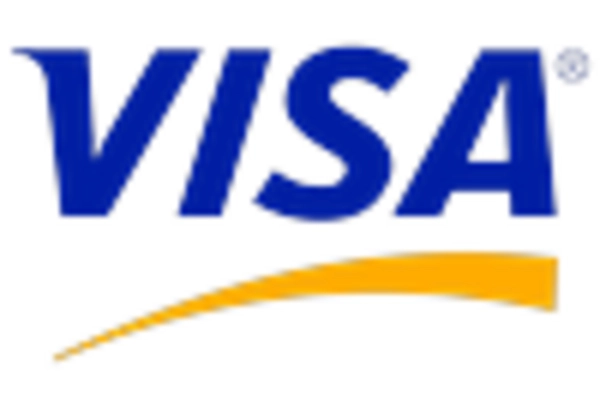Consumer Preference for Convenience
Consumer preferences are shifting towards convenience, significantly impacting the contactless payment market. As lifestyles become increasingly fast-paced, individuals seek payment methods that minimize friction during transactions. Surveys indicate that approximately 65% of consumers prefer contactless payments for their speed and ease of use. This preference is particularly evident among younger demographics, who are more inclined to adopt mobile wallets and contactless cards. Retailers are responding to this demand by integrating contactless payment options into their systems, thereby enhancing customer satisfaction and loyalty. The contactless payment market is poised for growth as businesses recognize the importance of catering to consumer preferences, with expectations of a compound annual growth rate (CAGR) of around 20% over the next five years. This trend underscores the necessity for businesses to adapt to evolving consumer behaviors to remain competitive.
Increased Focus on Health and Hygiene
The increased focus on health and hygiene is emerging as a crucial driver for the contactless payment market. As consumers become more health-conscious, the demand for payment methods that minimize physical contact is rising. Contactless payments offer a hygienic alternative to traditional cash transactions, aligning with consumer preferences for safer shopping experiences. Surveys indicate that nearly 60% of consumers are more likely to use contactless payment methods due to health concerns. Retailers are responding by implementing contactless solutions to ensure customer safety and satisfaction. This trend is likely to propel the contactless payment market, with expectations of a growth rate of approximately 15% annually over the next few years. The emphasis on health and hygiene not only influences consumer behavior but also encourages businesses to adopt contactless payment technologies as a standard practice.
Government Initiatives and Regulations
Government initiatives and regulations are playing a pivotal role in shaping the contactless payment market. In recent years, various state and federal policies have been introduced to promote digital payment solutions, aiming to enhance financial inclusion and security. For instance, the U.S. government has implemented regulations that encourage the adoption of contactless payment technologies among small and medium-sized enterprises (SMEs). These initiatives are expected to drive market growth, as they provide financial incentives and support for businesses transitioning to contactless systems. Furthermore, the contactless payment market is likely to benefit from increased funding for technological infrastructure, with projections suggesting that government investments could reach $1 billion by 2027. Such regulatory frameworks not only facilitate market expansion but also instill confidence among consumers and businesses alike.
Rise of E-commerce and Online Shopping
The rise of e-commerce and online shopping is significantly influencing the contactless payment market. As more consumers turn to online platforms for their shopping needs, the demand for secure and efficient payment methods has surged. In 2025, it is estimated that online sales will account for over 25% of total retail sales in the U.S., driving the need for contactless payment solutions that can seamlessly integrate with digital shopping experiences. Retailers are increasingly adopting contactless payment options to cater to this growing market, enhancing customer convenience and security. The contactless payment market is expected to see substantial growth as e-commerce continues to expand, with projections indicating a market value of $150 billion by 2026. This trend highlights the necessity for businesses to adopt innovative payment solutions to meet the evolving needs of online consumers.
Technological Advancements in Payment Systems
The contactless payment market is experiencing a surge due to rapid technological advancements in payment systems. Innovations such as Near Field Communication (NFC) and Radio Frequency Identification (RFID) are enhancing transaction efficiency and user experience. In 2025, it is estimated that over 70% of all transactions in retail settings will utilize contactless technology, reflecting a significant shift in consumer behavior. This trend is driven by the increasing demand for seamless payment solutions that reduce transaction times and enhance convenience. As businesses adopt these technologies, the contactless payment market is likely to expand, with projections indicating a market value exceeding $200 billion by 2026. The integration of advanced technologies not only streamlines payment processes but also fosters consumer trust, thereby propelling the growth of the contactless payment market.

















Leave a Comment